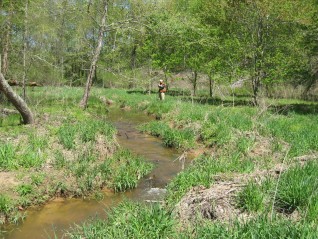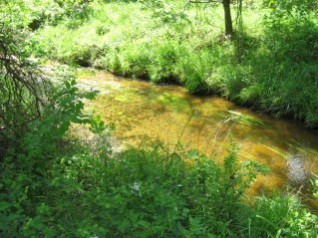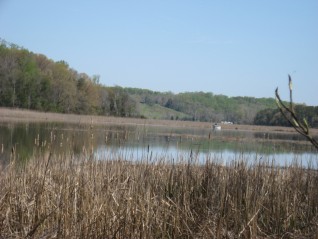Preserving Land
“Conservation will ultimately boil down to rewarding the private landowner who conserves the public interest.”
– Aldo Leopold, Conservation Economics (1934)
Conservation Easements: a Tool of Choice
For the private landowner interested in preserving land for the enjoyment of future generations, the donation of a conservation easement may be an effective and rewarding way to do it. A conservation easement is a voluntary legal agreement negotiated between a landowner and a qualified public agency or land trust, such as ours. It permanently retires some or all of the development rights of a property and specifies the prohibition of certain uses and practices that are inconsistent with conservation values. In return for donating a conservation easement, a landowner may obtain:
- lower estate and inheritance taxes;
- potential federal and state income tax deductions based on an appraised value of the easement; and
- limited state and local property tax credits.
Before making such a major financial decision, the prospective donor should consult his tax advisor or financial planner.
A conservation easement keeps protected property in private hands and on the tax rolls. Landowners may continue to own, reside on, use, and manage their property, sell it, or pass it on to their heirs. A conservation easement does not grant public access unless the landowner desires it. Being perpetual, it runs with the deed to the land; i.e., it is recorded in the local land records and applies to all successor owners.
What Lands Qualify?
In order to qualify for federal and state tax benefits, a donated conservation easement must serve one or more of four conservation purposes as defined by the Internal Revenue Service (IRS):
- The protection of relatively natural habitat of fish, wildlife, or plants, or similar ecosystem;
- The preservation of open space (including farmland and forest land) either for the scenic enjoyment of the general public or pursuant to a clearly delineated governmental policy and that will yield a significant public benefit;
- The preservation of an historically important land area or a certified historic structure; and/or
- The preservation of land areas for the outdoor recreation by, or education of, the general public.
To meet the test of having conservation value, a property should be 25 acres or more and possess specific definable conservation attributes, such as:
- productive farmland, significant woodlands (especially large, unfragmented forest suitable for forest interior dwelling species), wetlands, or wildlife habitat;
- land occupied by endangered, threatened, or rare species or their habitat or is otherwise rich in biodiversity or functioning ecosystems;
- Chesapeake Bay tributary buffer land;
- large contiguous or linked areas and clusters or corridors of open space;
- land, the protection of which would discourage sprawl development and contribute to regional greenways or ecosystem linkages;
- land adjacent to or within the viewshed of scenic byways or important cultural resources; and
- land proximate to other land already protected.
The Process, Step by Step
Once a landowner makes initial contact to propose a property for permanent protection–
- We visit it to determine its suitability. Maryland Environmental Trust (MET) may participate with the consent of the landowner.
- Without making assurances of the prospective donor’s eligibility for tax benefits, we provide factual information as to the requirements for claiming benefits. If interested, the landowner arranges for the property to be appraised.
- We also advise the landowner of the IRS requirement for lien subordination as well as potential costs associated with the project, including funding to help support the Conservancy’s monitoring and stewardship.
- We explore the property to document its structures and conservation attributes and prepare a preliminary evaluation against our criteria with a recommendation to our Board whether to accept the proposal. If MET is interested in co-holding the easement with us, they follow their own process independently and in parallel.
- After our Board gives its preliminary approval, we proceed with the project and gather additional pertinent information from local and state agencies.
- Once all parties agree to the terms to be included, we draft a Deed of Conservation Easement for review by the landowner and his attorney. We use the same template Deed of Conservation Easement as the MET
- The landowner works with lenders to subordinate any existing lien (mortgage or deed of trust) to the conservation easement pursuant to IRS requirements.
We prepare the final document which includes a baseline description of the property, its existing structures and conservation attributes with photographs, maps and other exhibits. - We ask the landowner to consider a voluntary contribution to our Stewardship Fund.
- After our Board approves the final document (and when co-holding, MET’s Board approves subject to Maryland’s Board of Public Works’ affirmation), the Deed of Conservation Easement is signed and recorded in the county’s land records.
The entire process from initial contact to signature and recording may take anywhere from three months to a year depending on its complexity. When MET is participating as co-holder, landowners who wish to donate an easement by the end of the year must contact us no later than September 15th.
To learn more about conservation easements, tax benefits, or the preservation process, call us any time at (301) 934-8175 or email info@conservecharles.org
Stewardship
The Conservancy for Charles County helps conservation-minded landowners protect their land not just for their lifetimes but in perpetuity. A land trust’s work is just beginning with the recording of a conservation easement at the county courthouse. In accepting and holding a conservation easement, we commit to maintaining its integrity through periodic stewardship that includes enforcement of its terms. Legal enforcement, of course, is a remedy of last resort.
Our goal is to maintain a good working relationship with landowners of conserved property and to help them understand their conservation easement. This is especially true for successive landowners who may have no prior experience with the limitations of a conservation easement on the uses of their land. Violations, when they occur, are usually unintentional and can be resolved through cooperative means.
- We monitor and document changes to the property and its uses over time compared to its recorded baseline.
- Site visits are conducted by trained volunteers. Owners are provided advance notice and are invited to participate. We provide a questionnaire regarding any changes and management practices since the previous visit or are planned for the future and follow up with a letter of compliance for the owner’s records.
Stewardship includes the administration of an easement, for example, securely maintaining accurate records, approving a request to site a new residence or structure, change a management practice, or exercise a specified right, determining whether an amendment is needed, or simply responding to a request for information.
A donor can be confident in the Conservancy’s commitment to the long-term defense of his easement. We are a charter member-owner of Terrafirma Risk Retention Group LLC, a one-of-a-kind captive charitable risk pool created by Land Trust Alliance and owned by participating land trusts. Terrafirma insures its members against the legal costs of defending conservation.
Stewardship of each easement entails costs and each new easement increases the financial burden. To ensure that the Conservancy will maintain the financial stability to monitor, defend, and enforce the terms of each of its easements, we established the Stewardship Endowment Fund. All contributions to this fund are restricted for easement protection. Each donor of a new conservation easement is asked to consider making a voluntary contribution. Contributions to the fund are welcome from all sources, however.

Evaluating a property for protection in Mount Vernon viewshed, Bryans Road

Conservancy-protected land on Popes Creek

Conservancy-protected land on Gilbert Run

Conservancy-protected marsh on Nanjemoy Creek

A cyclist riding the popular Indian Head Rail Trail

